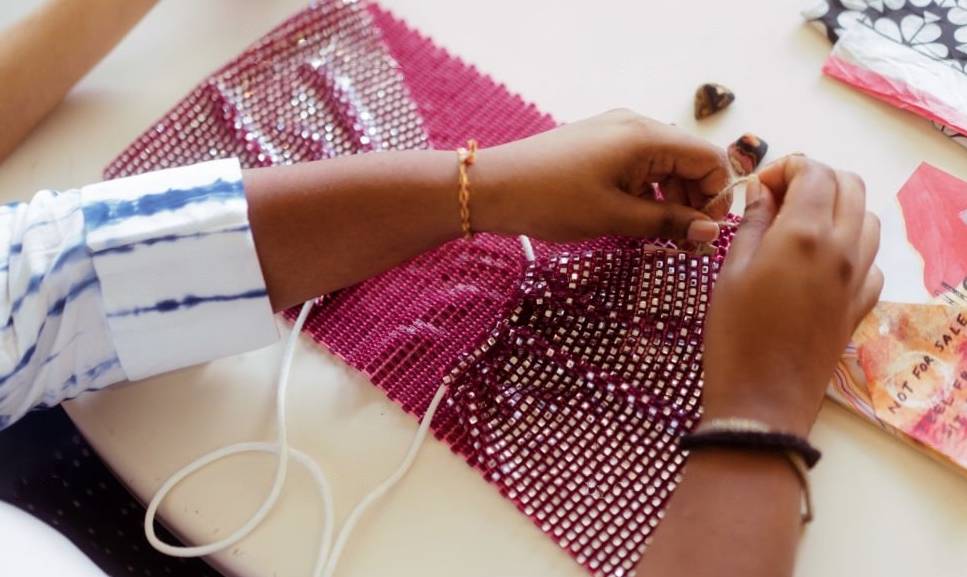Are you wondering how your choice of clothing can make a difference to our planet? Astoundingly, the fashion industry produces 10% of all humanity’s carbon emissions. This article will guide you in understanding the benefits of choosing sustainable clothing and how choosing them benefits not only you but also our environment.
Let’s dive right into a world where fashion meets sustainability!
Key Takeaways
- Sustainable fashion helps to reduce waste generation by producing clothes in smaller quantities, using eco-friendly materials, and promoting circular design principles.
- Choosing sustainable clothing supports fair wages and healthy working conditions for garment workers, creating a more just and equitable fashion industry.
- Sustainable clothing contributes to the reduction of carbon dioxide and greenhouse gas emissions by using eco-friendly materials and manufacturing processes with lower environmental impact.
- By selecting sustainable clothing, you can conserve natural resources, reduce your personal carbon footprint, support animal-friendly practices, conserve water resources, promote fair trade practices, and contribute to a healthier world for people and the planet.
What is Sustainable Fashion?
Sustainable fashion refers to clothing that is produced and designed in an environmentally friendly and socially responsible manner, with the aim of reducing waste generation and promoting fair working conditions.
Definition of sustainable fashion
Sustainable fashion is clothing made with care. It uses less water and energy than regular clothes. The materials are eco-friendly, like organic cotton or recycled fibers. Some brands even use renewable energy to make them! Sustainable fashion also means fair pay for the people who make the clothes.

They work in safe places too. It’s all part of a big plan to help our planet stay nice and healthy.
Examples of sustainable fashion brands
Here are some sustainable fashion brands:
- Patagonia: They are known for their commitment to environmental and social responsibility. They use recycled materials and organic cotton in their products.
- Everlane: This brand focuses on transparency and ethical production. They provide detailed information about the factories they work with and the costs associated with each item.
- Eileen Fisher: Eileen Fisher is dedicated to using sustainable materials like organic cotton, linen, and recycled fibers. They also have a take-back program where customers can return old clothing for recycling.
- Reformation: Reformation creates trendy and stylish clothing using eco-friendly materials such as TENCEL™ fabric and repurposed vintage pieces.
- People Tree: This brand specializes in fair trade clothing made from organic fabrics. They ensure that workers receive fair wages and good working conditions.
- Amour Vert: Amour Vert focuses on creating timeless pieces using sustainable materials such as TENCEL™ Modal fabric, organic cotton, and non-toxic dyes.
- Indigenous: Indigenous is committed to producing ethically made clothing using natural fibers like organic cotton, silk, and alpaca wool.
- Thought Clothing: Thought Clothing offers a wide range of sustainable garments made from natural fibers such as bamboo, hemp, and organic cotton.
- Outerknown: Outerknown is a brand that prioritizes sustainability throughout their supply chain by using recycled materials and reducing water consumption during production.
- Alternative Apparel: Alternative Apparel uses sustainable materials like organic cotton, recycled polyester, and low-impact dyes to create comfortable basics with a minimal environmental impact.
Importance of Sustainable Fashion
Sustainable fashion is crucial for various reasons, including its ability to reduce waste generation and promote fair wages and healthy work environments.
Reduced waste generation
Sustainable fashion is important because it helps to reduce waste generation. The fashion industry is known for its fast-paced production and high levels of waste. But by choosing sustainable clothing, you can contribute to a more environmentally friendly approach.
Sustainable brands often focus on producing clothes in smaller quantities, using eco-friendly materials, and promoting circular design principles. This means less fabric waste, fewer discarded items, and a reduced impact on landfills.
By opting for sustainable clothing options, you are actively participating in waste reduction efforts and supporting a more responsible fashion industry.
Fair wages and healthy work environment
Sustainable clothing ensures fair wages and a healthy work environment for workers. Many sustainable fashion brands prioritize ethical practices, paying their employees fair wages and providing safe working conditions.
This means that the people who make your clothes are treated fairly and not exploited for cheap labor. By choosing sustainable clothing, you can support these efforts to create a more just and equitable fashion industry.
Plus, when workers are paid fairly and have good working conditions, it improves their overall well-being and quality of life.
Reduced carbon dioxide and greenhouse gas emissions
Sustainable clothing helps reduce carbon dioxide and greenhouse gas emissions. By choosing eco-friendly materials, such as organic fibers or recycled fabrics, the production process creates fewer harmful gases.
Additionally, sustainable fashion brands often prioritize renewable energy consumption in their manufacturing processes, further reducing their carbon footprint. This means that by opting for sustainable clothing, you are actively contributing to the fight against climate change and helping to protect our environment for future generations.
Benefits of Choosing Sustainable Clothing

Sustainable clothing offers a range of benefits, including the conservation of natural resources, reduced carbon footprint, animal-friendly production methods, water conservation, support for fair and safe working conditions, and healthier outcomes for both people and the planet.
Conservation of natural resources
Sustainable clothing is essential for the conservation of natural resources. Choosing eco-friendly materials like organic cotton, hemp, or recycled fibers reduces the demand for non-renewable resources such as petroleum-based synthetic fabrics.
By using renewable energy and decreasing water usage in production processes, sustainable fashion helps to conserve these valuable resources. Additionally, opting for circular design principles promotes recycling and extends the lifespan of garments, further minimizing resource consumption.
Through these efforts, sustainable clothing plays a crucial role in preserving our planet’s limited natural resources.
Reduced carbon footprint
By choosing sustainable clothing, you can significantly reduce your carbon footprint. Sustainable fashion brands prioritize using eco-friendly materials and manufacturing processes that have lower greenhouse gas emissions compared to conventional methods.
With the increased focus on renewable energy consumption within the industry, sustainable clothing also contributes to decreased carbon dioxide emissions. By making this choice, you are actively taking part in reducing the environmental impact of the fashion industry and helping combat climate change.
Animal-friendly
Sustainable clothing is not only good for the environment, but it’s also animal-friendly. When you choose sustainable fashion, you are supporting brands that promote cruelty-free practices.
Animal lives are saved because these brands do not use materials derived from animals or engage in harmful testing methods. By avoiding fur, leather, and other animal-derived materials, sustainable clothing helps to protect biodiversity and preserve the lives of countless animals.
So when you opt for eco-friendly fashion, you’re making a compassionate choice that benefits both the planet and its inhabitants.
In addition to being animal-friendly, sustainable clothing offers many other benefits. It helps to reduce your personal carbon footprint by minimizing greenhouse gas emissions associated with the production of traditional garments.
Choosing clothes made from organic or recycled materials further supports environmental conservation efforts and reduces pollution caused by the fashion industry. Furthermore, sustainable fashion often prioritizes fair trade practices and ensures safe working conditions for garment workers.
Water conservation
Sustainable clothing also helps with water conservation. The fashion industry consumes a significant amount of water in various stages of production, including growing crops for fabric, dyeing textiles, and washing garments.
By choosing sustainable clothing made from organic or recycled materials, you can reduce the demand for water-intensive processes. For example, organic cotton uses less water compared to traditional cotton farming methods.
This means that by opting for sustainable fashion, you are contributing to conserving water resources and supporting a more environmentally friendly industry.
Support for fair and safe working conditions
Sustainable clothing goes beyond protecting the environment, it also focuses on promoting fair and safe working conditions. When you choose sustainable fashion brands, you are supporting companies that prioritize the welfare of their workers.
These brands ensure that employees are paid fair wages and work in healthy environments. By opting for sustainable clothing, you contribute to creating a more ethical and inclusive fashion industry where workers’ rights are respected.
Choosing sustainable fashion also means saying no to sweatshops and exploitative labor practices. Many mainstream fashion brands have been criticized for their involvement in poor working conditions and low wages.
However, by embracing sustainable clothing, you can make a difference by supporting brands that value fairness and safety for all workers involved in the production process.
When we support fair and safe working conditions through our choices as consumers, we send a powerful message to the industry at large. We demand transparency about supply chains and expect accountability from companies regarding worker treatment.
Healthier for people and the planet
Sustainable clothing is not only good for the environment but also for people’s health. Traditional clothing production often involves the use of toxic chemicals, which can be harmful to both workers and consumers.
However, sustainable fashion brands prioritize the use of organic materials and eco-friendly dyes, reducing the risk of exposure to harmful substances. Additionally, sustainable clothing tends to be made with natural fibers such as cotton or hemp, which are breathable and hypoallergenic, promoting better skin health.
By choosing sustainable clothing, we can create a healthier world for ourselves and future generations.
How to Achieve Sustainable Fashion

Embrace truly sustainable fashion by understanding the concept, avoiding greenwashing, and taking courses on sustainability. Read on to learn more!
Understanding the concept of truly sustainable fashion
Truly sustainable fashion is all about making clothing in a way that doesn’t harm the environment or the people who make it. It means using eco-friendly materials like organic cotton and recycled fibers, and making sure the production process doesn’t create a lot of pollution.
Sustainable fashion also focuses on fair trade practices, ensuring that workers are paid properly and have safe working conditions. By understanding the concept of truly sustainable fashion, you can make informed choices about what to buy and support brands that are doing their part to protect our planet.
Avoiding greenwashing
Greenwashing refers to when companies falsely claim their products or practices are environmentally friendly. To avoid falling for greenwashing in the fashion industry, it’s important to do your research.
Look for brands that provide transparent information about their sustainability efforts and certifications. Check if they use eco-friendly materials like organic cotton or recycled fibers.
Additionally, pay attention to the overall messaging of a brand – are they focusing on long-lasting quality or just promoting trends? By being informed and asking questions, you can support truly sustainable fashion and make a positive impact on the environment.
Taking courses on sustainability
- Learn about sustainable fashion practices and principles.
- Understand the impact of the fashion industry on the environment.
- Discover ways to reduce waste and promote ethical practices in fashion.
- Gain knowledge about eco – friendly materials and their benefits.
- Explore techniques for reducing carbon footprint through sustainable clothing choices.
- Learn about fair trade and its importance in the fashion industry.
- Understand how to make informed decisions when purchasing clothing.
- Become aware of the social and environmental issues associated with fast fashion.
- Acquire skills to support and promote sustainable fashion in your community.
- Stay updated on new advancements in sustainable fashion.
Conclusion
Choosing sustainable clothing offers numerous benefits for both the environment and people. By opting for eco-friendly materials, reducing water usage, and supporting fair working conditions, we contribute to conserving natural resources, decreasing our carbon footprint, and protecting animal welfare.
In addition to these tangible advantages, sustainable fashion allows us to make a positive impact on the planet while expressing our personal style. So why not choose ethical clothing that is good for you and the world?.
FAQs
1. What are the benefits of choosing sustainable clothing?
Choosing sustainable or green fashion brings many benefits like reduced water usage, decreased carbon footprint, and ensures animal welfare.
2. How does ethical clothing help the environment?
Ethical clothing uses ecofriendly materials and biodegradable components which helps in natural resources conservation and reduces greenhouse gas emissions.
3. Is it true that sustainable clothes can be good for my health too?
Yes! Sustainable or organic clothing made from ecofriendly materials can bring health benefits as they use fewer chemicals during production.
4. Can I still express my personal style with environmentally friendly clothes?
Surely! Slow fashion values quality over quantity so you can enjoy unique pieces that reflect your personal style while also being conscious about the environment.
5. Are green fashions expensive to buy compared to regular ones?
Not always. While some ethical clothing might come at a higher price initially, others offer affordable prices and they often last longer than regular clothes saving more money in the long run.

As a dedicated mother and passionate software developer, she weaves her diverse experiences into captivating stories that inspire and engage readers. Emma's love for sustainable living and environmental consciousness permeates both her personal and professional life. When she's not immersed in the world of coding and software development, Emma can be found nurturing her family and tending to her thriving organic garden. Her commitment to sustainable practices extends to every aspect of her life, from repurposing household items to embracing eco-friendly technologies.










